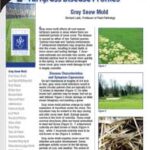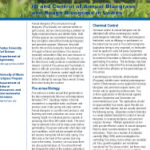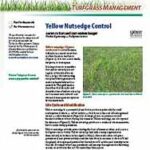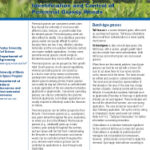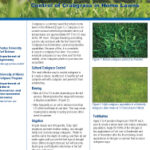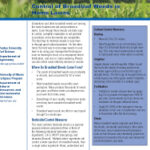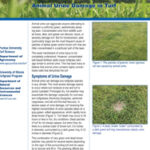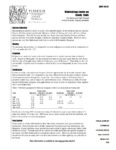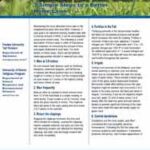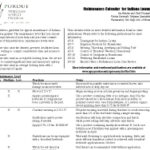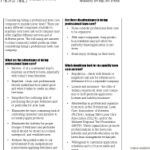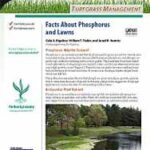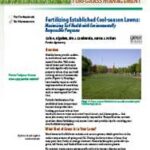Extension Publications
Turfgrass Disease Profiles: Anthracnose (BP-108-W)
Purdue Extension Publication
Anthracnose is caused by a fungus that survives and thrives on dead and decaying organic matter, and is primarily a disease of intensively managed annual bluegrass and creeping bentgrass used on golf courses. This publication discusses how to identify anthracnose, and examines options for controlling the disease.
Turfgrass Disease Profiles: Gray Leaf Spot (BP-107-W)
Purdue Extension Publication
Gray leaf spot is a foliar disease that affects perennial ryegrass and tall fescue. Moderate outbreaks of gray leaf spot result in clusters of thin, off-colored turf. Severe outbreaks, however, will result in the death and decay of extensive areas and ruin the entire turf stand. This publication describes the symptoms and development of this disease, and provides management options.
Turfgrass Disease Profiles: Brown Patch (BP-106-W)
Purdue Extension Publication
Brown patch is caused by a fungal pathogen that affects all cool-season turfgrass species. Moderate to severe outbreaks on high-maintenance creeping bentgrass and annual bluegrass can result in thin, poor quality turf that may be predisposed to algae and moss infestation. This publication describes the symptoms and development of this disease, and provides management options.
Turfgrass Disease Profiles: Dollar Spot (BP-105-W)
Purdue Extension Publication
Dollar spot is caused by a fungal pathogen and is a common concern on golf course turf, especially creeping bentgrass and annual bluegrass greens, tees, and fairways, where it can result in poor turf quality and appearance. This publication describes the symptoms and development of this disease, and provides management options.
Turfgrass Disease Profiles: Red Thread (BP-104-W)
Purdue Extension Publication
Turfgrass Disease Profiles: Leaf Spot/Melting Out (BP-103-W)
Purdue Extension Publication
Leaf spot and melting out are different diseases with similar symptoms and pathogen characteristics. They both attack Kentucky bluegrass, perennial ryegrass, and tall fescue, and appear to cause the most damage to golf course roughs, sports turf, and residential lawns. This publication describes the symptoms and development of this disease, and provides management options.
Turfgrass Disease Profiles: Gray Snow Mold (BP-101-W)
Purdue Extension Publication
Gray snow mold affects all cool season turfgrass species in areas where there are extended periods of snow cover. This publication discusses how to identify gray snow mold, and examines options for controlling the disease.
ID and Control of Annual Bluegrass and Rough Bluegrass in Lawns (AY-41-W)
Purdue Extension Publication
Controlling annual bluegrass (Poa annua) and rough bluegrass (Poa trivialis) in lawns is difficult, and relies on both cultural and chemical control. This publication describes these weeds and offers management strategies.
Yellow Nutsedge Control (AY-19-W)
Purdue Extension Publication
This publication describes the life cycle and identification of yellow nutsedge and recommends cultural and chemical management options for homeowners. A similar publication is available for turf professionals: Turfgrass Management Sedge Control for Turf Professionals (AY-338-W)
Animal Urine Damage in Turf (AY-327-W)
Purdue Extension Publication
Animal urine can aggravate anyone attempting to maintain a uniformly green, aesthetically pleasing lawn. For homeowners, pets (particularly dogs) are the most frequent cause of patches of darker green and/or brown turf, that are often concentrated in a particular part of the lawn. This publication describes symptoms of animal urine damage in turf and provides some management solutions.
Maintaining Lawns on Sandy Soils (AGRY-98-03)
Purdue Extension Publication
Species Selection Maintaining an attractive lawn on sandy soils depends largely on the turfgrass species selected. Species that have improved drought tolerance include tall fescue and some cultivars of Kentucky bluegrass. Fine leaf fescues include red, sheep, hard, and chewing fescues and these grasses perform well under droughty conditions, especially in partial shade. However, these […]
7 Simple Steps to a Better Homelawn (AY-32-W)
Purdue Extension Publication
Maintaining the most attractive homelawn in the neighborhood takes time and effort. However, if your goal is a good-looking, healthy lawn with a minimal amount of effort, it can be accomplished using some simple steps. The following is a brief description of those steps in order of importance, with emphasis on minimizing the amount of time and input dedicated to your lawn. test
Maintenance Calendar for Indiana Lawns (AY-27-W)
Purdue Extension Publication
The “Maintenance Calendar” provides seasonal lawn tips for cool season grasses. Three maintenance levels are established depending on the amount of money and time you are willing to invest. The calendar provides practices and notes on what you should do each month to ensure a healthy lawn.
Should I Hire a Professional Lawn Care Service? (AY-26-W)
Purdue Extension Publication
This publication addresses the advantages of hiring a professional lawn care service. It also discusses what to look for in a lawn care service and what you can do to help the lawn care service make your yard look better.
Facts About Phosphorus and Lawns (AY-334-W)
Purdue Extension Publication
This publication for both professionals and homeowners examines the role that phosphorus plays in turfgrass growth, explains how to determine the needs of specific turf stands, and provides suggestions for proper application to reduce the risk of contaminating surface waters.
Fertilizing Established Lawns (AY-22-W)
Purdue Extension Publication
Fertilizing established lawns keeps the lawn looking good and reduces how much you have to water and control weed, insect, and disease pests — that saves you money and is environmentally responsible. This publication answers questions about fertilizing cool-season lawns and provides tips for creating your own fertilization program.
